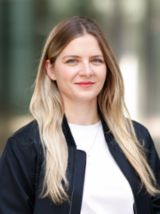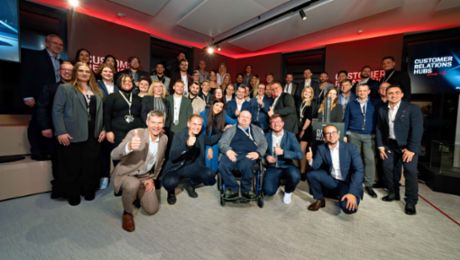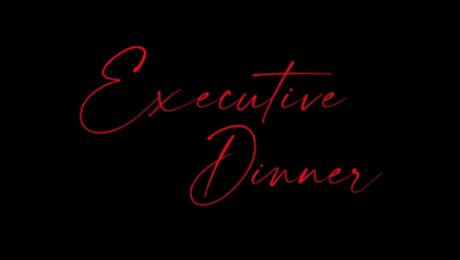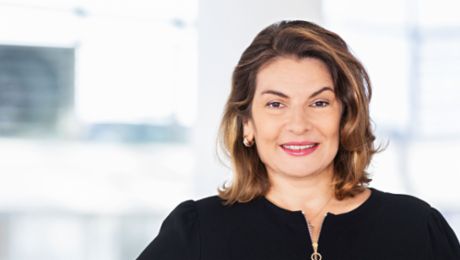Maryam, you've been with Porsche since last summer. Throughout your career, you’ve worked with various luxury brands in the retail sector. What surprised you when you joined Porsche?
Maryam Djavadi: When I reflect on my early Porsche experience, I was truly impressed by the diversity and number of retail touchpoints already established globally. Porsche’s unique design, combined with a powerful and diverse model range, is mirrored across our retail formats. This undoubtedly contributes to our strong unique selling proposition in the automotive industry, based on my experience and what I discovered so far.
Porsche has set itself the target of creating a seamless customer journey, not only advancing digital touchpoints but also expanding the retail landscape. In addition to the classic Porsche Centers, the brand has established other formats, particularly in urban areas. Could you give us an overview?
Djavadi: Certainly, in 2017, Porsche first established the "Porsche Studio" format. These are located in urban city centers with the aim of representing the brand and informing customers and potential customers about our products and services. We want to reach our customers where they are – following the motto: "Be where I am." There are now nearly 30 Porsche Studios worldwide. A year later, in 2018, we also introduced the temporary sales pop-up format "Porsche NOW." Furthermore, we are constantly evaluating the feedback of our customers and investors to further reinforce our urban retail formats.
Could you explain the pop-up format in more detail?
Djavadi: Porsche NOW was introduced in 2018 as an innovative and temporary sales pop-up format. The idea is to create a dynamic, time-limited, and immersive brand experience that goes beyond the classic dealership model. We want to bring Porsche closer to people by setting up the Porsche NOW concept in high-traffic urban areas. In addition to brand presence, the focus of the pop-up formats is clearly on generating new potential customers and sales.
Doesn't this present competition to the traditional Porsche Center?
Djavadi: No, on the contrary. With the urban retail formats, we allow people to get in touch with the brand who might not have considered visiting Porsche otherwise. The brand’s success is certainly driven by both, customer loyalty and the attraction of new clientele, reinforcing the importance of our existing customer base while also highlighting the ongoing commitment to look forward as well.
For example, during a weekend stroll with their family in the city. They can be inspired and consulted at Porsche NOW. On-site, they can directly purchase a vehicle or discuss the next steps at the Porsche Center after their first conversation at Porsche NOW. The pop-ups are operated by our local retail partners. They are directly connected to the local Porsche Center.
How have the worldwide markets received and implemented the Porsche NOW concept?
Djavadi: We set the framework and define the basic setup of the Porsche NOW concept. Then, in collaboration with the local retail organization, individual adaptations are made. We also rely on the expertise of our retail partners. They know where our target groups are and how to best engage them. Personally, I find the creative execution of our projects truly impressive. For example, in Canada, we had five pop-ups running simultaneously for the launch of the new fully electric Macan. These were partly indoor but also outdoor locations.
Exciting!
Djavadi: Absolutely! With every new Porsche NOW, it’s exciting to see how the concept is shaped and activated by our retail partners. Since its introduction in 2018, over 50 Porsche NOW pop-ups have been successfully installed worldwide. One of the key goals of Porsche NOW is to meet new potential customers. Every Porsche NOW is unique. In London, we had a four-week pop-up at "The Strand" last autumn. During this time, 16 events were held, including two exciting live painting sessions with a local artist.
What do you think makes a Porsche NOW successful?
Djavadi: I’m convinced that location and activation are key to success. The location is crucial. The pop-ups have a very flexible duration, from four weeks to five months. So, high-traffic locations need to be chosen, as there is not much time to establish oneself. Furthermore, there are still barriers to entering a Porsche location, as is the case with other luxury brands. It’s important to present ourselves openly. Ultimately, a pop-up also thrives on activation. With exciting collaborations and events, you can attract various target groups. Our retail partners are also very creative in this area. Events range from live concerts, watchmaker workshops with Porsche Design Timepieces, to panel discussions with exciting guests. We often integrate our Porsche brand partners, such as Aesop or Burmester. It’s inspiring to see the creative ideas that are implemented and how much work goes into the design.
And how do you measure the success of a pop-up?
Djavadi: That’s actually not that easy. We leverage retail analytics to measure key performance indicators such as visitor footfall, lead generation, and conversion rates at the Porsche NOW pop-up. These serve as initial success measures, alongside absolute vehicle sales. However, when someone first truly connects with the brand through Porsche NOW, they rarely buy a car immediately. Usually, test drives and further consultations take place until the individual dream car is configured and ordered. This often continues even after the pop-up has ended.
In the future, we - together with our investors - leave nothing to chance right from the initial selection of the Porsche NOW location. Our self-developed Market Potential Intelligence tool utilizes artificial intelligence to combine customer, market, dealer and vehicle-related data in order to place the right format in the right location.
What role does sustainability play in the Porsche NOW concept?
Djavadi: Sustainability is an essential part of the Porsche NOW concept. The pop-up elements can be produced locally and reused multiple times. For example, in 2023, we had a Porsche NOW pop-up in Munich. After five months, it was dismantled and rebuilt a few weeks later in Berlin. Whenever possible, we try to recycle elements of the concept and integrate recyclable materials. When we take over premises for Porsche NOW, we try to keep as much of the original state as possible and mainly work with our reusable modules.
Which international locations have proven particularly successful for Porsche NOW?
Djavadi: This is hard to answer in general. We have implemented the Porsche NOW format in 28 countries so far. We gain new insights from each location. We closely collaborate with our investors and highly appreciate their valuated feedback. For instance, together we lately identified the importance of window activation and are currently working on future solutions for our urban retail formats.
What can we look forward to this year?
Djavadi: We have a lot planned for this year. I don’t want to reveal too much yet and spoil it for the markets and retail partners, but we can look forward to sales pop-ups all around the world. Porsche NOW pop-ups were just recently opened in Sydney and Taipei. And there will be a few more to come this year. We will also continue expanding the Porsche Studios: Our colleagues in Korea just opened the fifth Porsche Studio, as will our colleagues in the USA and we will also look forward to openings in Turkey and Mexico.
In addition, we are constantly challenging ourselves and optimizing our urban retail formats. For example, with our multisensory project, we are enhancing the customer experience for all senses: sight. touch. taste. smell. hearing.



